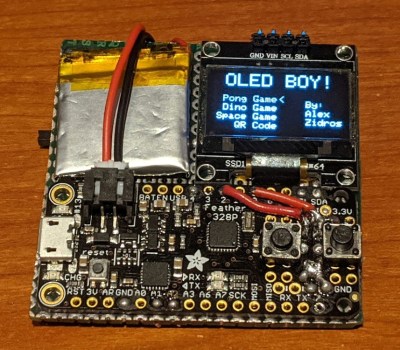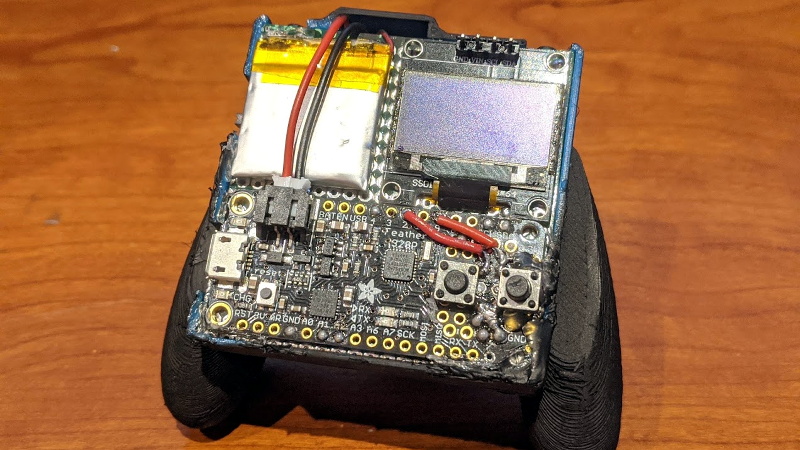With little more than an Arduino, an OLED display, and some buttons, it’s easy to build your own faux-retro game system. There’s even a growing library of titles out there that target this specific combination of hardware, thanks in no small part to the Arduboy project. But unless you’re content to play Circuit Dude on a breadboard, at some point you’ll probably want to wrap the build up in a more convenient form.
Like many that came before it, the OLED handheld created by [Alex Zidros] takes inspiration from a Nintendo product; but it’s not the Game Boy. Instead, his design is based on a 3D printed grip for the Switch Joy-Cons that he found on Thingiverse. After tacking on a holder for the PCB, he had the makings of a rather unique system.
 We especially like the offset SSD1306 OLED display. Not because we think a game system with an asymmetrical layout is a particularly sound design decision, but because it gives the whole build a rather cyberpunk feel. When combined with the exposed electronics, the whole system looks like it could have been cobbled together from a futuristic dumpster. Which is high praise, as far as we’re concerned.
We especially like the offset SSD1306 OLED display. Not because we think a game system with an asymmetrical layout is a particularly sound design decision, but because it gives the whole build a rather cyberpunk feel. When combined with the exposed electronics, the whole system looks like it could have been cobbled together from a futuristic dumpster. Which is high praise, as far as we’re concerned.
Opposite the display is a LiPo pouch battery that [Alex] says was liberated from a portable speaker, and down below is an Adafruit Feather 328P. There are two tactile switches mounted to the front of the Feather, and in something of a departure from these sort of builds, there are two more on the shoulders of the 3D printed case. Everything is held together with nothing more exotic than a scrap of perfboard, making it easy for anyone who might want to build their own version.
If you prefer your Arduino and OLED gaming to come in a slightly more familiar form factor, the build that was done inside of a Dreamcast Visual Memory Unit (VMU) has always been a favorite around these parts.
















Innovation in this area is always cool to see, you never know how someone will come up with a new design or set up. But I’ll say this, as someone who does more 3d printing than hardware hacking nowadays that print is horrible and giving me a tick!
fwiw lots of people who do utilitarian prints instead of cosmetic prints just have their settings and nozzle configured to spew out plastic quickly (yet cohesively) so they can make large, structural shapes without waiting until they’re a dusty skeleton. My prints don’t have the best surface finish, but they’re strong and fast as hell and dimensioned well enough for assembly. Sometimes articulation. I have come to kind of like the more coarse, utilitarian finish; it’s grippy, feels interesting to one’s fingers, and has a look that makes it very apparent that it’s 3d printed. People always seem to like that. Well, people who don’t get upset about my print quality at least lol. My print failure rate is also basically zero at this point, so it’s definitely a working configuration. Just not optimized for a nice finish.
It’s actually amusing how people emphasize a constraint of a recent technology to imply that their stuff is technologically up to date. Like in the 80s with 7 segment LEDs and LCDs, there would be labels or signs with “futuristic” 7 segment fonts. Then carbon fiber, in order to fulfill it’s promise of ultimate lightness with ultimate strength it was left unpainted and the surface may have been textured due to all the excess resin being sucked out. Ppl began to associate the flaw, the compromise, in the finish as the epitome of high technology so you got all these stupid fake carbon fiber finishes on things and carbon fiber effect wraps that made things heavier in order to make them look like they were high tech lightweight stuff. Now ppl like to see the surface flaws of 3D printing because it’s cool and makes things look high tech. Noticed already some cheap electronics coming with a striated texture on their injection molded cases now.
I’m pretty sure the striations tend to be cost optimised mold making.
(Im the guy who made the Handheld)
I’m aware how garbage the print is and I don’t care that much about the quality of prints used for my electrical hobbyist projects.
I only really only care how quick I can make an enclosure.
Function over form
It’s cool and all but trying to play games for any length of time on that tiny thing would make you go blind faster than masturbation ….
Just sayin’ …….
THANKS FOR THE CIRCUIT DUDE SHOUT OUT! 😁 I appreciate it!